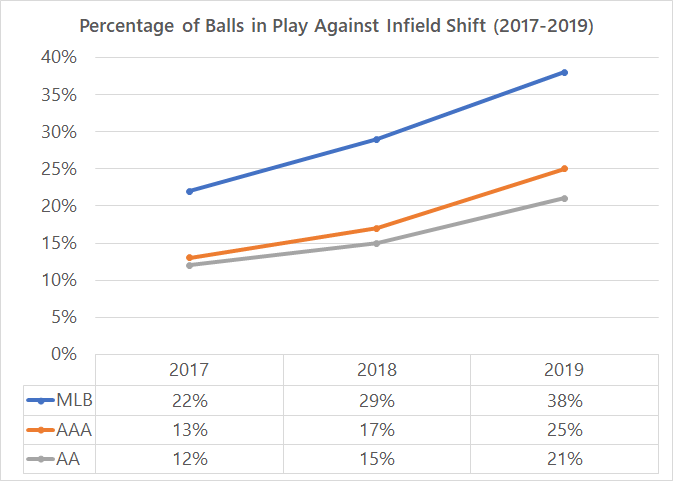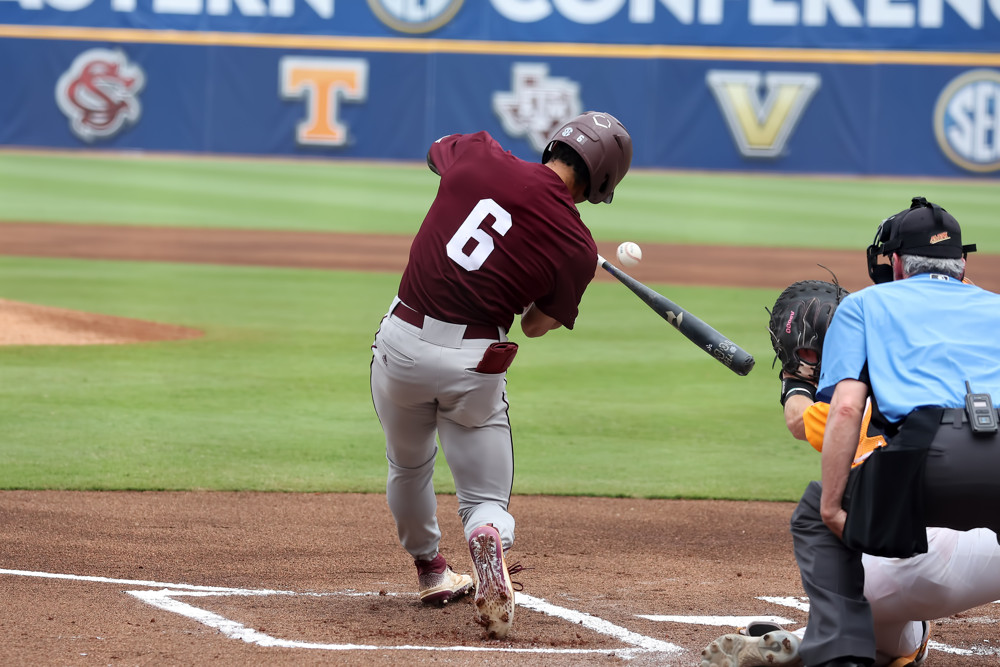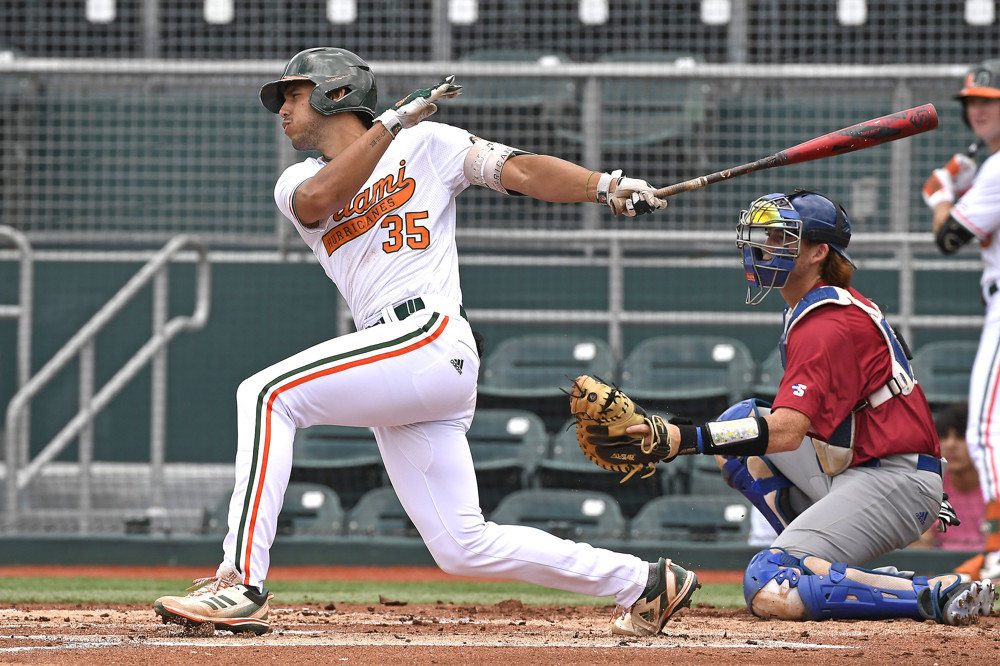Over the next month leading up to the 2019 MLB Amateur Draft, Baseball Info Solutions will be publishing a series of position-by-position scouting reports from our Video Scouts for the top-50 collegiate draft prospects. Each player is graded by the 20-80 scouting scale, given a comprehensive evaluation, and assigned a floor and a ceiling comparison, which indicate–if a player makes the Major Leagues–the range of the type of player into which he can develop.
Full coverage:
Catchers
Corner Infield (Part 1)
Corner Infield (Part 2)
Middle Infield (Part 1)
Middle Infield (Part 2)
Outfield (Part 1)
Outfield (Part 2)
Left-Handed Pitching (Part 1)
Left-Handed Pitching (Part 2)
Right-Handed Pitching (Part 1)
Right-Handed Pitching (Part 2)
The next installment in this series covers corner infielders, which will be split into two articles. There are 10 total first and third basemen in our top 50, all of whom are likely to come off the board in the first four or five rounds of the draft.
Both corner infield spots offer a ton of offensive upside, but many of these players leave a bit to be desired defensively. California’s Andrew Vaughn, arguably the nation’s top hitter, projects to be the highest college first baseman drafted since 1996, when Travis Lee was selected second overall by the Twins out of San Diego State. Beyond Vaughn, Josh Jung and Logan Wyatt have bats that profile well at the corners. Michael Busch and Drew Mendoza should contribute at the plate regardless of where they end up on the diamond.
Andrew Vaughn, 1B
University of California (JR, 2019)
R/R 6-0, 214 lbs
Date of Birth: 04/03/1998
Hit- 60 (70) Power- 60 (70) Run- 40 (40) Arm- 50 (50) Field- 50 (50)
Written by Mitch Glessner
Analysis
In 2017, Vaughn burst onto the college scene with a freshman slash line of .349/.414/.555. His sophomore campaign was even more impressive, as he went on to win the prestigious Golden Spikes Award for 2018. The consensus All-American hit .402 with 23 HR and 63 RBI as a sophomore, and has continued to rake as a junior, with a 1.214 OPS and 11 HR through 177 plate appearances. He has the chance to solidify his reputation as one of the best players in the country by being one of the top picks in the 2019 draft.
Vaughn possesses the most explosive bat in his class, with plus power to all fields. He has a rare ability to drive balls that weren’t hit squarely. Vaughn has boasted a 12.0 at-bat per home run rate so far in his junior season, down from an incredible 8.7 last year. He generates power by utilizing his strong lower half and extremely quick hands. His set up in the box is very simple with minimal wasted movement. Vaughn finds his rhythm and timing in his loading phase by cocking the bat upward upon the pitcher’s release (hand movement and mechanics are similar to those of Javier Baez). This puts his hands in a good launch position, and allows them to work on plane and in the zone for a long time. His exceptional hand usage in his swing gives him complete plate coverage.
Vaughn has a very patient approach at the plate. He’s in no rush early in the count and rarely chases pitches. His good feel for the strike zone allows him to work deep into counts and walk at a high rate. He has increased his BB% from 17 percent last season to over 22 percent this season.
His short, stocky frame doesn’t fit the traditional first baseman mold, but he has tremendous footwork around the bag to make up for what he lacks in length. He has a great feel for digging out bad throws, as he works through the ball from the ground up, much like a middle infielder. He handles the in-between hop by letting the ball get deep into his hips.
Outlook
Vaughn’s offensive polish is rare, and he possesses more than enough ability to hit at a high level in the majors. While his bat overshadows his defense, he has the skills to be an average, everyday defender. He has the quality makeup to be a potential franchise player at the Major League level.
Projection: Elite offensive first baseman who should hit for both average and power.
Ceiling: Paul Goldschmidt
Floor: Mike Napoli
Draft Expectation: Top-3 Pick
Josh Jung, 3B
Texas Tech University (JR, 2019)
R/R 6-02 215 lbs
Date of birth: 02/12/1998
Hit- 55 (65) Power- 50 (60) Run- 45 (40) Arm- 60 (60) Field- 50 (50)
Written by Dominic Asta
Analysis
All Josh Jung has done at Texas Tech in his three years is hit, hit, and hit. He slashed .392/.491/.639 as a sophomore and smacked 12 homers and 17 doubles. He has continued that offensive prowess in his junior year, and has looked solid defensively at third. He was a first-team All-Big 12 honoree, a member of the USA Collegiate National Team, and hit .429 at the 2018 College World Series. He is looking to solidify himself as a top-10 draft pick in his junior season.
Jung has an upright stance with a big leg kick and a level swing that produces many hard-hit line drives. He moves quite a bit before the pitch is delivered, but has a very balanced swing with good weight shift and momentum going forward with his leg kick. He excels at keeping inside the ball and shooting it to the opposite field and up the middle. He doesn’t try to do too much with the pitch, and is content to spray line drives across the field. His frame and hard contact would make you believe that he has above-average power, though he has yet to tap fully into his power potential. He has the pure strength, bat speed and swing to produce above-average power, but needs to pull and lift the ball more to realize this potential. He also displays good patience at the plate and his bat-to-ball skills help him keep his strikeouts down. He has increased his BB% from just over 12 percent his sophomore year to over 19 percent this season. He should be able to produce a high OBP at the next level.
Jung is not a great athlete and some have doubts on whether he will need to switch to first base in pro ball. He gets the most out of his athleticism and has great hands and instincts at third base. Texas Tech has even started playing him at shortstop in the second half of the season. He will probably never win a Gold Glove or have great range, but he should be able to stick at the hot corner. His arm is above-average and he is strong at moving forward or back on grounders and using his strong arm to throw on the run or make a deep throw from third. He will need to improve his flexibility and agility if he wants to expand his range and defense. Although he has below-average speed, he is not a base clogger and has good instincts on the basepaths, allowing him to go first-to-third and even swipe a few bags.
Outlook
Josh Jung has one of the highest floors in the draft with his above-average offensive game that could skyrocket if he starts to hit for more home run power. He should be able to stay at the hot corner with his cannon arm and strong instincts for the position. He is a proven player who has performed his entire college career, as well as at the College World Series his sophomore year. It will be a surprise if he is not picked in the first round when the draft rolls around in June.
Projection: Above-average-hitting third baseman with a high floor and developing power.
Ceiling: Ryan Zimmerman
Floor: David Freese
Draft expectation: Top-20 pick
Michael Busch, 1B/OF
University of North Carolina (JR, 2019)
L/R 6-00, 207 lbs
Date of Birth: 11/09/1997
Hit- 55 (60) Power 50 (55) Run- 45 (45) Arm- 45 (45) Field- 50 (50)
Written by Harris Yudin
Analysis
A three-year starter at North Carolina, Busch has been an on-base machine since stepping foot in Chapel Hill. To date, he owns a .286/.434/.497 slash line with 124 walks and only 91 strikeouts in his collegiate career, tacking on 28 home runs and 29 doubles. Through his first 210 plate appearances this season, he owns a 1.051 OPS, with 23 of his 48 hits going for extra bases.
Busch boasts an advanced approach and excellent bat control. He is extremely patient and doesn’t chase many pitches out of the zone, but also isn’t afraid to attack first-pitch fastballs. He also protects the plate well, rarely whiffing at would-be strikes. The Tar Heels’ No. 2 hitter stands slightly open and utilizes a small leg kick, staying balanced and keeping his head on the ball all the way through his smooth, effortless swing. He uses the whole field, often beating the shift with line drives.
Busch has displayed above-average in-game power, but that is more a result of his pure hitting ability and knack for making opposing pitchers pay for mistakes than it is of natural, raw power. He mainly uses a gap-to-gap approach, but there is room for additional pop if he were to add more lift to his swing.
Carolina’s current roster situation has forced Busch, typically a first baseman, to play a lot of left field this season. He has fared relatively well out there; while his range is limited, he gets decent reads and hasn’t been a liability getting to balls in the gap. His mediocre arm is best suited for left, but he could be serviceable in either corner. A lack of size may force him into the outfield more regularly in pro ball, and while he may not have a true position at which he could thrive, he is athletic enough to handle a number of spots on the diamond and should provide some defensive versatility — he also played second base in the Cape Cod League in 2018.
Outlook
Concerns over his future defensive home may give teams reason to hesitate on draft day, but his athleticism should alleviate some of those concerns. His feel for hitting and exceptional on-base skills should help provide him a seamless transition to the next level, and a little added power could turn him into a dynamic major league hitter.
Projection: Undersized player with no true position but a polished offensive profile.
Ceiling: J.D. Drew
Floor: Matt Joyce
Draft Expectation: Rounds 1-2
Logan Wyatt, 1B
University of Louisville (JR, 2019)
L/R, 6-04, 230lbs
Date of Birth: 11/15/1997
Hit- 50 (60) Power- 50 (60) Run- 30 (30) Arm- 45 (50) Field- 45 (50)
Written by Shawn Larner
Analysis
As a freshman, Logan Wyatt spent most of his days behind a future top pick in Brendan McKay. He saw a mere 18 at-bats and struggled. He may have learned a thing or two from McKay, however, because once he left Wyatt stepped right in and put his talent on full display. He went on to have an OPS over 1.000 and was one of the premier hitters in college baseball. While he hasn’t quite matched that so far in 2019, he is certainly capable.
Wyatt is generally a pull hitter from the left side, but he does display excellent bat control and likes to choke up a bit on the bat in all situations. His simple, quiet stance leads him into his smooth lefty swing that can also be powerful. While he hasn’t shown off tremendous power, he is a big kid and when paired with his mechanically-sound swing, the power will come. Wyatt has increased his isolated power numbers from .183 last season to .218 in his junior campaign.
The tool that stands out most for Wyatt is his plate discipline. He is a very patient hitter, drawing many walks and waiting for a pitch to which he can do damage. Logan has an incredible 25 percent walk rate and has walked over 50 times already this season. His pitch recognition skills go right along with the discipline, and he shows an ability to identify pitches and lay off. This is another reason he could find more power with more repetition. He also walks more than he strikes out thanks to his patience, and he brings a presence with him every time he steps into the box.
Defensively, Wyatt is not going to wow anybody, but he will make the plays he needs to make over at first base. He’s athletic enough to provide a little bit of range and should continue to improve. He has also flashed soft hands to help out his teammates on throws in the dirt.
Outlook
A move to left field seems far-fetched, and he should be able to contribute every day at first base given his ability at the plate. His on-base abilities will get him an opportunity, but tapping into his power will make him stick.
Projection: On-base machine with potential 20-home run power.
Ceiling: Justin Morneau
Floor: James Loney
Draft expectation: Rounds 2-3
Drew Mendoza, 3B
Florida State University (JR, 2019)
L/R, 6-05, 225 lbs
Date of Birth: 10/10/1997
Hit- 40 (50) Power- 55 (65) Run- 40 (35) Arm- 55 (55) Field- 40 (40)
Written by Will Hoefer
Analysis
Mendoza is an extra large third baseman who has performed akin to a four true outcomes guy at Florida State — walk, strikeout, home run, double. Over 50 percent of his collegiate plate appearances have ended in one of those four outcomes. Naturally, this leads to excitement over his power potential, and concern over his ability to tap into it.
Mendoza keeps his hands high and features a bit of a leg kick. He has above-average bat speed, while staying balanced and using his length throughout his swing. He has plus raw power that he has yet to fully tap into. He has a pretty left-handed swing and a swing path that keeps the barrel of his bat in the zone. He has a very passive approach at the plate that allows him to work the count and draw a good amount of walks. Mendoza has produced walk rates of 16 percent in 2017, 16 percent in 2018, and a whopping 25 percent currently in his junior season. He will always have swing and miss in his game, through his combination of long levers and average-at-best athleticism. But he has worked hard in 2019 on controlling his body at the plate, and has developed decent bat control while maintaining plus bat speed.
Most of his time in the garnet and gold has been spent as a third baseman, but Mendoza has, at best, average footwork and hands at the hot corner. Below-average speed in a large frame bodes poorly for his future at the position. Lacking plus arm accuracy all but dooms him to a future at first base or in the corners of an outfield.
Outlook
Mendoza, whose development was delayed by injuries his freshman year, has yet to fulfill his lofty expectations, but his tantalizing tools still remain. Even with a below-average glove, his strong arm and offensive upside will help keep his overall profile in Day 1 discussions.
Projection: Big raw power and patience with an uncertain defensive future.
Ceiling: Aubrey Huff
Floor: Greg Bird
Draft expectation: Rounds 2-3
Other corner infielders to keep an eye on:
Andrew Daschbach, Stanford University
Davis Wendzel, Baylor University
Ryan Kreidler, UCLA



